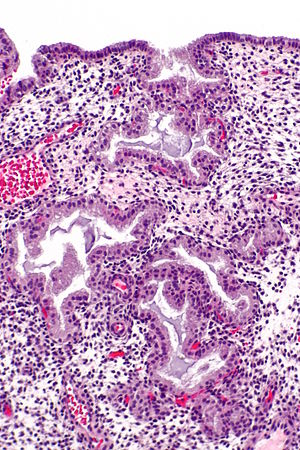Secretory phase endometrium
Jump to navigation
Jump to search
The printable version is no longer supported and may have rendering errors. Please update your browser bookmarks and please use the default browser print function instead.
| Secretory phase endometrium | |
|---|---|
| Diagnosis in short | |
 Secretory phase. H&E stain. | |
|
| |
| LM | dependent on day post-ovulation - see microscopic |
| LM DDx | endometrial hyperplasia with secretory changes, endometrium with hormonal changes,proliferative phase endometrium |
| Site | endometrium |
|
| |
| Other | normal finding |
Secretory phase endometrium, abbreviated SPE, is a common diagnosis in endometrial specimens.
General
- Secretory phase = luteal phase.
- Gynecologists prefer the ovarian descriptor, i.e. luteal phase; pathologists go by what they see, i.e. Secretions in the (endometrial) glands.
Gross
- Thickened endometrium.
Microscopic
Early secretory phase
Features - post-ovulatory day 1-5:[1]
- Glands: secretory vacuoles.
- First basal to the epithelial nuclei (infranuclear vacuoles).
- Then apical to the epithelial nuclei (supranuclear vacuoles).
- Mitoses may be present - common when vacuoles are subnuclear.
Mid secretory phase
Features - post-ovulatory day 6-8:[1]
- Glands: Mucus in glands.
- Stroma: Edema (empty space around the glands).
Late secretory phase
Features - post-ovulatory day 9-12:[1]
- Stroma:
- Spiral arterioles.
- Predecidual changes -- mnemonic NEW:
- Nucleus central.
- Eosinophilic cytoplasm key feature (may be subtle to the novice).
- Well-defined cell borders.
Premenstrual
- Stroma: neutrophils, scattered lymphocytes, stromal balls ("blue balls"); "stromal condensation".
- Glands: apoptosis at the base of the gland.[2]
Notes:
- Stromal condensation (stromal balls) - premenstrual - stromal cells tightly packed together; nuclei molded together like in small cell tumours.[3]
- Gland-to-stroma ratio is increased in late secretory phase and menstruation.[4]
- Endocervical epithelium (ECE) has a morphology similar to the epithelium of secretory phase endometrium (SPE):
- ECE - grey foamy appearing cytoplasm.
- SPE - eosinophilic cytoplasm.
- Most useful feature to differentiate ECE and SPE is the accompanying stroma.
DDx:
- Endometrial hyperplasia with secretory changes.
- Endometrium with hormonal changes.
- Proliferative phase endometrium - may have some changes of secretory endometrium; <50% of glands have subnuclear vacuoles or <50% of cells in the glands have subnuclear vacuoles.[5]
Images
Sign out
ENDOMETRIUM, BIOPSY: - SECRETORY PHASE ENDOMETRIUM.
ENDOMETRIUM, ASPIRATION: - SECRETORY PHASE ENDOMETRIUM.
ENDOMETRIUM, CURETTAGE: - SECRETORY PHASE ENDOMETRIUM.
ENDOMETRIUM, BIOPSY: - SECRETORY PHASE ENDOMETRIUM, EARLY.
With additional stuff
ENDOMETRIUM, BIOPSY: - SECRETORY PHASE ENDOMETRIUM. - SCANT ENDOCERVICAL MUCOSA WITHIN NORMAL LIMITS.
ENDOMETRIUM, BIOPSY: - SECRETORY PHASE ENDOMETRIUM. - ENDOCERVICAL MUCOSA AND STRIPPED ENDOCERVICAL EPITHELIUM WITHIN NORMAL LIMITS.
ENDOMETRIUM, BIOPSY: - SECRETORY PHASE ENDOMETRIUM. - BENIGN SUPERFICIAL EXOCERVICAL EPITHELIUM. - SCANT BENIGN ENDOCERVICAL EPITHELIUM.
Evidence of shedding
ENDOMETRIUM, CURETTAGE: - SECRETORY PHASE ENDOMETRIUM WITH FINDINGS SUGGESTIVE OF SHEDDING (EPITHELIAL APOPTOSIS, INFLAMMATORY CELLS - ESPECIALLY NEUTROPHILS). - BENIGN EXOCERVICAL AND ENDOCERVICAL MUCOSA.
Micro
The sections show endometrium with a normal gland-to-stroma ratio. The glands are mildly dilated, tortuous and have mucus within them. The glandular epithelium is simple and non-pseudostratified. The stroma is edematous and has a decidual reaction. No mitotic activity is apparent.
See also
References
- ↑ 1.0 1.1 1.2 Tadrous, Paul.J. Diagnostic Criteria Handbook in Histopathology: A Surgical Pathology Vade Mecum (1st ed.). Wiley. pp. 237. ISBN 978-0470519035.
- ↑ Colgan T. 22 June 2009.
- ↑ GAG. 6 Oct 2009.
- ↑ URL: http://www.pathologyoutlines.com/topic/uteruspatternapproach.html. Accessed on: 6 December 2012.
- ↑ Mazur, Michael T.; Kurman, Robert J. (2005). Diagnosis of Endometrial Biopsies and Curettings: A Practical Approach (2nd ed.). Springer. pp. 14. ISBN 978-0387986159.








